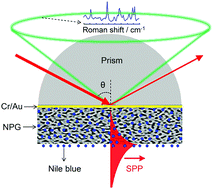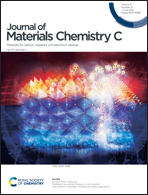Facile fabrication of nanoporous gold films for surface plasmon resonance (SPR) sensing and SPR-based SERS†
Abstract
Nanoporous gold (NPG) films have both propagating and localized surface plasmon resonance (PSPR and LSPR) effects, and their routine applications for surface-enhanced Raman scattering (SERS) spectroscopy are exclusively based on the LSPR effect. This work reports for the first time the Kretschmann-type surface plasmon polariton (SPP) excited SERS application of NPG thin films. NPG films with thicknesses of less than 100 nm were prepared on glass substrates using the sputtering–dealloying combination. Nile blue molecules that were adsorbed on the NPG film were investigated using both SPP sensing and SPP-excited SERS techniques, and the experimental results were compared with those obtained using dense gold films. The comparison revealed that the NPG film can offer both higher SPR sensitivity and stronger SERS signals than the dense gold film. This is because the NPG film enables the surface plasmon mode to interact with the adsorbed molecules in the full thickness of the film, whereas the dense gold layer limits the interaction to the monolayer thickness at the surface. In addition, the surface plasmon coupled directional emission of the Raman signal was observed with the NPG film, and this unique feature enables the SERS signal to be easily and efficiently collected. The work shows the outstanding applicability of NPG films for the high-sensitivity recognition and detection of chemical and biological molecules based on SPP sensing and SPP-excited SERS.



 Please wait while we load your content...
Please wait while we load your content...